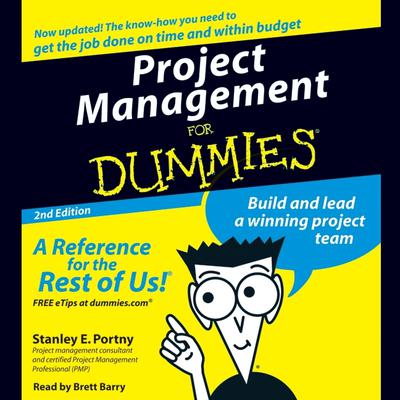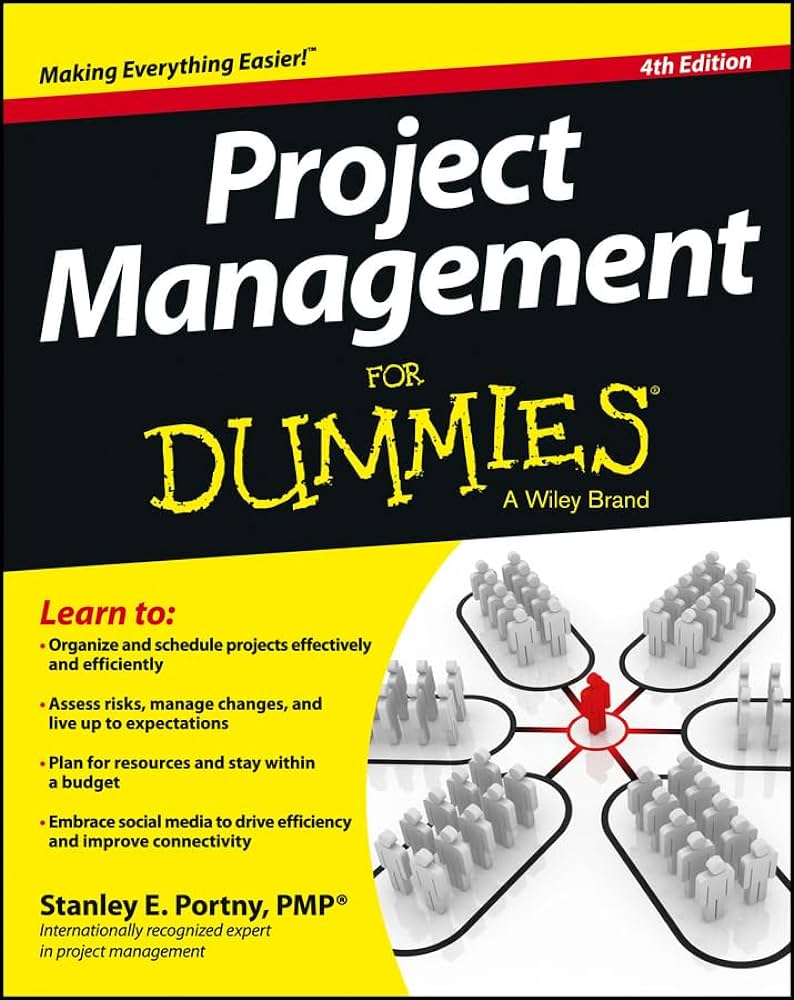Stanley E. Portny’s “Project Management For Dummies” audiobook provides practical guidance for managing projects effectively. It covers essential tools, techniques, and strategies.
Project management is crucial for achieving business goals efficiently. Stanley E. Portny’s “Project Management For Dummies” audiobook is an invaluable resource for both novices and experienced managers. It demystifies complex project management concepts, making them accessible and easy to understand.
The audiobook covers a wide range of topics, including planning, execution, and closing projects. Listeners gain insights into budgeting, scheduling, and risk management. The practical advice helps improve project success rates. This audiobook is a must-have for anyone looking to enhance their project management skills. It empowers listeners to lead projects with confidence and achieve desired outcomes.
Introduction To Stanley E. Portny’s Guide
Stanley E. Portny’s “Project Management For Dummies” is a must-read for project managers. This guide simplifies complex project management concepts. It’s perfect for both beginners and seasoned professionals.
The audiobook version makes learning even more accessible. Listen on the go and absorb valuable insights effortlessly.
The Genesis Of A Project Management Classic
Stanley E. Portny has over 30 years of project management experience. His expertise shines through in this comprehensive guide. He covers every aspect of project management.
This book has become a classic in the field. Its practical advice and clear explanations make it indispensable. Readers appreciate its step-by-step approach and real-world examples.
- Clear and concise language
- Actionable tips and techniques
- Real-world examples
Audiobook Format: Bridging The Gap
The audiobook format of “Project Management For Dummies” bridges the gap for busy professionals. You can learn while commuting, exercising, or relaxing at home.
This format ensures you don’t miss out on valuable knowledge. It’s narrated in a clear, engaging manner, making it easy to follow.
| Feature | Benefit |
|---|---|
| Mobile Learning | Learn anytime, anywhere |
| Engaging Narration | Easy to follow and understand |
| Flexible Listening | Adjust speed as needed |
This audiobook is an excellent resource for anyone serious about project management. It’s a great way to stay updated with best practices and new trends.
Key Concepts Simplified
Stanley E. Portny’s “Project Management For Dummies Audiobook” breaks down complex concepts. This book simplifies project management for everyone. Let’s explore some key ideas from the audiobook.
Project Life Cycle Essentials
Understanding the project life cycle is crucial. It includes several phases:
- Initiation
- Planning
- Execution
- Monitoring and Controlling
- Closure
Each phase has distinct goals. For instance, the initiation phase defines the project. The planning phase outlines tasks, timelines, and resources. During execution, the project team carries out the plan. Monitoring and controlling ensure the project stays on track. Finally, the closure phase wraps up the project.
Setting Realistic Goals And Objectives
Setting clear goals is a vital part of project management. Goals should be SMART:
- Specific: Clearly defined and unambiguous
- Measurable: Quantifiable to track progress
- Achievable: Realistic and attainable
- Relevant: Aligned with broader objectives
- Time-bound: With a clear deadline
Objectives translate goals into actionable steps. Each objective should support the main goal. This ensures the project remains focused and efficient.
Planning Your Project
Planning your project is the first step to success. Stanley E. Portny’s “Project Management For Dummies Audiobook” is a great guide. It helps you break down tasks and manage resources. Let’s explore two key areas: Creating a Workable Schedule and Budgeting Basics.
Creating A Workable Schedule
Creating a schedule is like making a roadmap. It tells you what to do and when. Start by listing all tasks. Use tools like Gantt charts for a visual plan. Break big tasks into smaller, manageable ones. This makes it easier to track progress.
Below is a sample Gantt chart:
| Task | Start Date | End Date |
|---|---|---|
| Task 1 | 01/01/2023 | 01/05/2023 |
| Task 2 | 01/06/2023 | 01/10/2023 |
Set milestones for key points in your project. This helps you stay on track. Review and update the schedule as needed. Flexibility is key.
Budgeting Basics
Budgeting is important for any project. It keeps your spending in check. Start with a detailed list of all costs. Include materials, labor, and unexpected expenses. This helps you avoid surprises.
Here are some budgeting tips:
- Use a spreadsheet to track expenses.
- Set aside a contingency fund.
- Review the budget regularly.
Below is a sample budget table:
| Item | Estimated Cost | Actual Cost |
|---|---|---|
| Materials | $1,000 | $950 |
| Labor | $2,000 | $2,100 |
Regular updates help you stay within budget. Adjust as needed to keep your project on track.
Execution And Monitoring
The audiobook “Stanley E. Portny – Project Management For Dummies” delves into the core aspects of project management. One crucial phase is Execution and Monitoring. This phase ensures tasks are completed effectively and progress is tracked accurately. Let’s explore key components of this phase.
Leading A Project Team
Leading a project team involves guiding and motivating team members. The project manager assigns tasks based on skills and availability. Regular meetings are essential to discuss progress and challenges. Open communication fosters collaboration and problem-solving. Recognize and celebrate team achievements to boost morale. Documenting decisions and actions keeps everyone informed and accountable.
Tracking Progress And Performance
Tracking progress involves monitoring task completion and deadlines. Use project management software to update task status. Create a progress chart to visualize milestones achieved. Regularly review the project schedule to identify delays. Performance tracking measures the efficiency of task completion. Set clear performance metrics for team members. Use a performance dashboard for real-time updates. Prepare status reports to keep stakeholders informed. Address issues promptly to avoid project derailment.
Risk Management
Risk Management is a crucial aspect of any project. It involves identifying, assessing, and controlling risks to ensure project success. Stanley E. Portny’s Project Management For Dummies Audiobook provides valuable insights into effective risk management strategies.
Identifying Potential Pitfalls
Knowing potential pitfalls helps in proactive planning. Start by brainstorming possible issues with your team. Use a risk register to document all identified risks.
- Technical challenges
- Resource constraints
- Budget overruns
- Timeline delays
Analyze each risk’s impact and likelihood. This helps prioritize which risks need immediate attention.
Mitigation Strategies
Mitigation strategies are actions to reduce risk impacts. Create a risk mitigation plan for each identified risk.
| Risk | Mitigation Action |
|---|---|
| Technical challenges | Provide additional training and resources |
| Resource constraints | Hire temporary staff or reallocate tasks |
| Budget overruns | Monitor expenses closely and adjust budget forecasts |
| Timeline delays | Reevaluate project schedule and add buffer time |
Regularly review and update the risk register. This ensures timely response to new risks.

Effective Communication Strategies
Effective Communication Strategies are vital for successful project management. Stanley E. Portny’s “Project Management For Dummies Audiobook” offers valuable insights into these strategies. This section focuses on engaging stakeholders and proper reporting and documentation.
Stakeholder Engagement
Engaging stakeholders is crucial for project success. Stakeholders include clients, team members, and managers. Clear communication ensures everyone understands the project’s goals and progress.
Use the following methods to engage stakeholders:
- Regular Meetings: Hold weekly or bi-weekly meetings.
- Email Updates: Send brief updates on milestones.
- Feedback Sessions: Encourage feedback to improve processes.
- Workshops: Conduct workshops to train and align the team.
Reporting And Documentation
Reporting and documentation keep projects on track. They provide a record of decisions, tasks, and progress. Good documentation helps avoid misunderstandings.
Key elements of effective reporting and documentation:
| Element | Description |
|---|---|
| Project Charter: | Defines the project’s scope, objectives, and participants. |
| Progress Reports: | Updates on the project’s status and any issues. |
| Minutes of Meetings: | Records decisions and action items from meetings. |
| Final Report: | Summarizes the project’s achievements and lessons learned. |
Stanley E. Portny emphasizes the importance of clear, concise, and regular reporting. This ensures everyone is on the same page and can address issues promptly.
Leveraging Technology
Leveraging technology is crucial in today’s fast-paced project management world. Stanley E. Portny’s “Project Management For Dummies Audiobook” offers valuable insights. It teaches how to use modern tools effectively. This section highlights the best practices for leveraging technology in project management.
Tools For Project Management
There are many tools available for project managers. These tools help in planning, tracking, and completing projects.
- Microsoft Project: A powerful tool for scheduling and tracking.
- Asana: Great for team collaboration and task management.
- Trello: Uses boards and cards for visual project management.
- JIRA: Ideal for software development and agile projects.
These tools streamline project workflows. They ensure tasks are completed on time. They also improve team communication and coordination.
Integrating New Technologies
Embracing new technologies can enhance project management. Artificial Intelligence (AI) and Machine Learning (ML) can predict project outcomes. They help in resource allocation and risk management.
Cloud-based solutions allow teams to work from anywhere. They offer real-time updates and data sharing. This boosts efficiency and collaboration.
Automation reduces manual tasks. It ensures accuracy and saves time. Automated reminders and notifications keep everyone on track.
Using Big Data Analytics helps in making informed decisions. It provides insights based on data trends and patterns.
Integrating these technologies improves project success rates. It makes project management more efficient and effective.

Case Studies And Real-world Applications
Stanley E. Portny’s Project Management For Dummies Audiobook offers valuable insights. It shares practical knowledge through engaging case studies. These real-world applications help listeners understand project management better.
Success Stories
Portny’s audiobook includes success stories that inspire and educate. These stories feature projects that achieved their goals. They show how effective project management leads to success.
| Project | Outcome | Key Takeaways |
|---|---|---|
| Tech Startup Launch | Successful product release |
|
| Construction Project | Completed on time |
|
These stories highlight the importance of clear goals and effective communication. They show that planning and teamwork are crucial for success.
Lessons Learned From Failure
The audiobook also shares lessons learned from failures. These stories are equally important. They show what went wrong and why.
- Marketing Campaign
- Outcome: Poor engagement
- Lesson: Understand your audience
- Software Development
- Outcome: Delayed release
- Lesson: Manage scope creep
These failures teach valuable lessons about risk management and adaptability. They remind us that mistakes are opportunities to learn and improve.
Conclusion: The Journey Of Continuous Learning
Stanley E. Portny’s “Project Management For Dummies Audiobook” is a treasure. It offers deep insights into project management. The audiobook is an excellent resource for beginners and experienced managers alike. Embracing the principles in this audiobook means embarking on a journey of continuous learning.
The Ever-evolving Field Of Project Management
Project management is not static. It evolves with time. New tools and methods emerge regularly. Staying updated with these changes is crucial. Portny’s audiobook helps listeners stay informed. It covers the latest trends in project management. This keeps you ahead in your career.
Key areas of evolution include:
- Agile Methodologies: Agile is now a popular approach. It focuses on flexibility and customer feedback.
- Remote Project Management: Managing teams remotely is more common. It requires new skills and tools.
- Technology Integration: Using technology to streamline processes is vital. Tools like AI and automation are game-changers.
Final Thoughts And Future Directions
Project management will continue to evolve. Future trends will shape its direction. Portny’s audiobook prepares you for these changes. It emphasizes the importance of adaptability. Being open to learning is key.
Consider these future directions:
- Increased Automation: Automation will reduce manual tasks. Focus will shift to strategic planning.
- Enhanced Collaboration Tools: New tools will improve team communication. They will make collaboration easier.
- Data-Driven Decisions: Data will play a bigger role. Decisions will be based on data insights.
Stay curious and keep learning. Portny’s audiobook is a great starting point. It sets the foundation for a successful project management career.

Conclusion
Stanley E. Portny’s “Project Management For Dummies Audiobook” is an essential resource. It simplifies complex project management concepts. Ideal for beginners and professionals alike, it offers practical advice. Enhance your skills and manage projects effectively with this comprehensive guide. Don’t miss out on this valuable tool for success.



